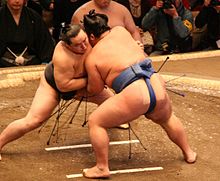Sumo
Sumo (相撲, sumō) is a Japanese full-contact sport.[1]

In sumo, a wrestler (rikishi) attempts to force another wrestler out of a circular ring (the dohyō) 4.55 metres in diameter. Also, the rikishi try to use their skill to force an opponent to touch the ground with anything other than the soles of his feet.
Sumo tournaments (basho) take place in Tokyo, Osaka, Nagoya and Fukuoka. There are a total of 6 major professional tournaments (known as honbasho) per year, in January, March, May, July, September and November.
A tournament normally lasts for 15 days and features matches from different divisions. The top 5 ranks are known as the "Top division", also called the Makuuchi (幕内) or Makunouchi (幕の内). It is fixed in size and always contains 42 rikishi.
The ranks included in the top division are yokozuna, ozeki, sekiwake, komusubi and maegashira.
Rikishi
changeSumo wrestlers (rikishi) are ranked into a hierarchy based on win-loss statistics in competitive tournaments.[2]
Grand champions
changeThose who have earned the highest rank are grand champions (yokuzuna).[3]
- Akashi, 16th century[3]
- Maruyama, (1712-1749)[3]
- Tanikaze (Kajinosuke, 1750-1795)[3]
- Onagawa (1758-1805)[3]
- Ao no Matsu (1791-1851)[3]
- ...
- Chiyonofuji Mitsugu (born 1955)[4]
- Takanosato (born 1952)[3]
- Futahaguro Koji (born 1963)[3]
- Hokuto-umi, (born 1963)[3]
- Onokuni (born 1962)[3]
- Asahifuji (born 1960)[3]
- Akebono (born 1970)[3]
For a full list of those rikishi who have held the title of Yokozuna, see List of yokozuna.
Foreign-born competitors
changeSumo has changed in modern times. Foreign-born wrestlers are part of the sport. For example, Konishiki[5] and Akebono[6] are Hawaiian-born athletes who earned places for themselves.
In 2008, Kotooshu from Bulgaria won a championship. In that same year, two top wrestlers, Asashoryu and Hakuho, were Mongolian. Hakuho won the Nagoya tournament with no losses, 15-0.
References
change- ↑ Nussbaum, Louis-Frédéric. (2005). "Sumo" in Japan Encyclopedia, p. 914.
- ↑ Nussbaum, "Sumotori" in Japan Encyclopedia, pp. 914-915.
- ↑ 3.00 3.01 3.02 3.03 3.04 3.05 3.06 3.07 3.08 3.09 3.10 3.11 Nussbaum, "Yokozuna (Sumo Grand Champions)" at p. 915; retrieved 2012-2-27.
- ↑ Nussbaum, "Chiyonofugi" at p. 117; retrieved 2012-2-27.
- ↑ Sumo Reference, Konishiki Yasokichi Archived 2012-02-07 at the Wayback Machine; retrieved 2012-2-27.
- ↑ Japan Sumo Association, "Akebono" Archived 2012-03-07 at the Wayback Machine; retrieved 2012-2-27.